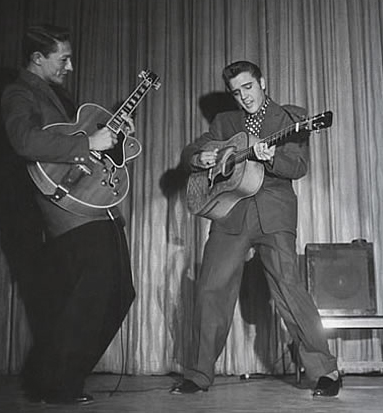Rockabilly music is an exciting, purely American art form that emerged in the 50’s and swept away teens with its high-octane rhythms. Guitarists such as Scatty Moore (with Elvis Presley) and Cliff Gallup (with Gene Vincent), along with Carl Perkins, created a style as popular today as it was 30 and even 40 years ago. The original rockabilly guitarists played semi-hollow Gretsches and Guilds, but our guitar lesson works on any ax that suits you.
An important part of the rockabilly sound is slapback echo-an electronically generated single repeat that immediately follows the original note. Slapback was first produced in the recording studio using tape echo, but you can duplicate it with an inexpensive digital or analog delay unit. Adjusting for the tempo of the song, set your delay to produce a single repeat of about 100 milliseconds. Make sure the second note is about the same volume as the first. For an example of this technique listen to Elvis’ “Mystery ‘Bain“ from the famous Sun sessions. To avoid getting confused, learn the music thoroughly before experimenting with slapback. Playing the notes staccato will bring out the echo clearly. It sounds great on both rhythm and lead guitar parts.
“Hot Roddin’ Boogie” is a 12-bar blues shuffle in E. It’s presented in two sections: Example 1 is the rhythm and Example 2 is a guitar solo filled with essential rockabilly ideas; Ex. 2 is designed to be played over EX 1. To hear how the solo sounds in context, record Ex. 1 or having a friend play it, then play Ex. 2 against it. This is important because although the licks aren’t difficult, their rhythmic placement is essential to achieving a classic rockabilly sound.
Example 1 is a typical single-note rhythm-guitar riff-a boogie-woogie bass line with a pedal tone on the upper tonic note. Carl Perkins popularized this lick in such songs as “Blue Suede Shoes, ” “Matchbox,” and “Honey Don’t.” Mute the strings slightly with the heel of your picking hand and use strict alternate picking, beginning with a downstroke. Watch for the slight variation in measures 4,8, and 12, where the D sharp comes around. Measures 9 and 10 are tricky because of the wider skips to the pedal tone on the third string. For the second ending I’ve included a classic rockabilly
tag that uses an E6/9 chord.
Our Example 2 solo begins with a third-string Bb to B sharp slide followed by a double-stop on the open first and second strings. This lick repeats five times and moves across two measures. Wait a half-beat before beginning the phrase, as indicated by the eigth-note rest at the start of measure 1.
Use a clean, twangy tone with lots of reverb. Practice each section slowly until you feel comfortable before working up to teh suggested tempo. When you can nail the whole tune at 144 BPM, pull on your white bucks, slick back your hair, and get ready to knock ’em dead!
Guitar Lesson
http://truefire.com/audio-guitar-lessons/hot-roddin-boogie.mp3
